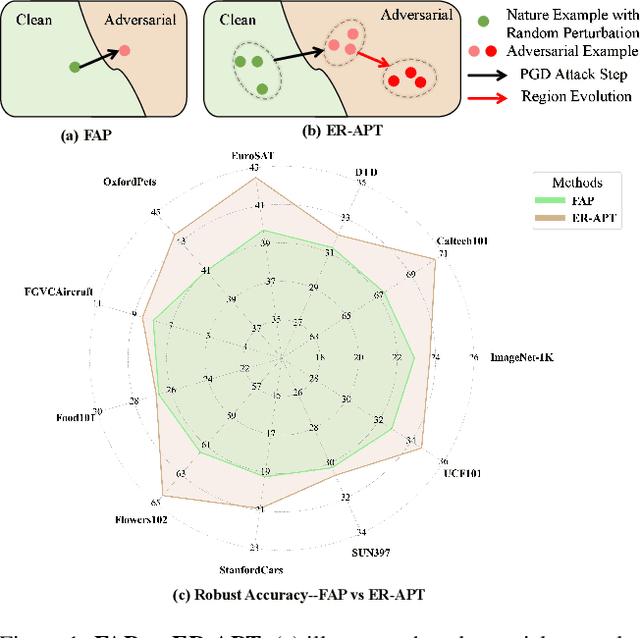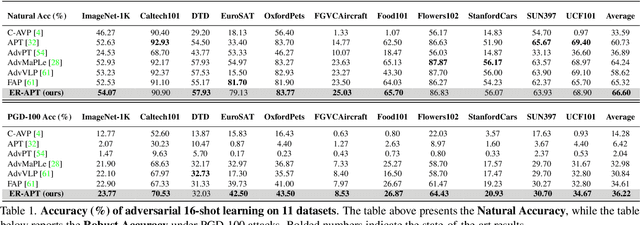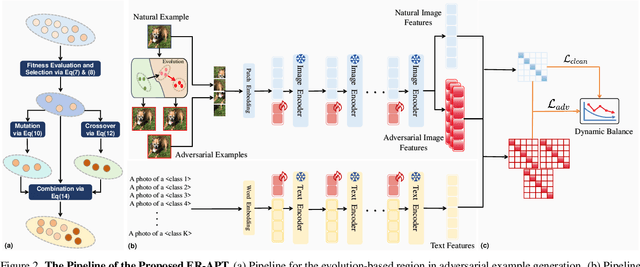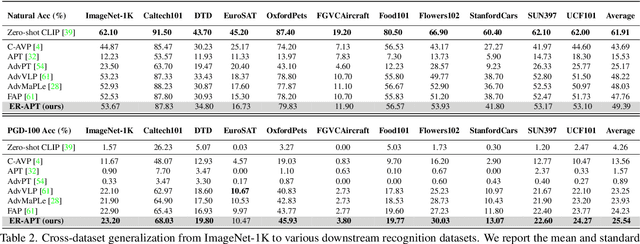Ke Ma
Stephen
Learn Faster and Remember More: Balancing Exploration and Exploitation for Continual Test-time Adaptation
Aug 18, 2025Abstract:Continual Test-Time Adaptation (CTTA) aims to adapt a source pre-trained model to continually changing target domains during inference. As a fundamental principle, an ideal CTTA method should rapidly adapt to new domains (exploration) while retaining and exploiting knowledge from previously encountered domains to handle similar domains in the future. Despite significant advances, balancing exploration and exploitation in CTTA is still challenging: 1) Existing methods focus on adjusting predictions based on deep-layer outputs of neural networks. However, domain shifts typically affect shallow features, which are inefficient to be adjusted from deep predictions, leading to dilatory exploration; 2) A single model inevitably forgets knowledge of previous domains during the exploration, making it incapable of exploiting historical knowledge to handle similar future domains. To address these challenges, this paper proposes a mean teacher framework that strikes an appropriate Balance between Exploration and Exploitation (BEE) during the CTTA process. For the former challenge, we introduce a Multi-level Consistency Regularization (MCR) loss that aligns the intermediate features of the student and teacher models, accelerating adaptation to the current domain. For the latter challenge, we employ a Complementary Anchor Replay (CAR) mechanism to reuse historical checkpoints (anchors), recovering complementary knowledge for diverse domains. Experiments show that our method significantly outperforms state-of-the-art methods on several benchmarks, demonstrating its effectiveness for CTTA tasks.
Architectural Co-Design for Zero-Shot Anomaly Detection: Decoupling Representation and Dynamically Fusing Features in CLIP
Aug 11, 2025Abstract:Pre-trained Vision-Language Models (VLMs) face a significant adaptation gap when applied to Zero-Shot Anomaly Detection (ZSAD), stemming from their lack of local inductive biases for dense prediction and their reliance on inflexible feature fusion paradigms. We address these limitations through an Architectural Co-Design framework that jointly refines feature representation and cross-modal fusion. Our method integrates a parameter-efficient Convolutional Low-Rank Adaptation (Conv-LoRA) adapter to inject local inductive biases for fine-grained representation, and introduces a Dynamic Fusion Gateway (DFG) that leverages visual context to adaptively modulate text prompts, enabling a powerful bidirectional fusion. Extensive experiments on diverse industrial and medical benchmarks demonstrate superior accuracy and robustness, validating that this synergistic co-design is critical for robustly adapting foundation models to dense perception tasks.
Taming Diffusion Transformer for Real-Time Mobile Video Generation
Jul 17, 2025Abstract:Diffusion Transformers (DiT) have shown strong performance in video generation tasks, but their high computational cost makes them impractical for resource-constrained devices like smartphones, and real-time generation is even more challenging. In this work, we propose a series of novel optimizations to significantly accelerate video generation and enable real-time performance on mobile platforms. First, we employ a highly compressed variational autoencoder (VAE) to reduce the dimensionality of the input data without sacrificing visual quality. Second, we introduce a KD-guided, sensitivity-aware tri-level pruning strategy to shrink the model size to suit mobile platform while preserving critical performance characteristics. Third, we develop an adversarial step distillation technique tailored for DiT, which allows us to reduce the number of inference steps to four. Combined, these optimizations enable our model to achieve over 10 frames per second (FPS) generation on an iPhone 16 Pro Max, demonstrating the feasibility of real-time, high-quality video generation on mobile devices.
LidarPainter: One-Step Away From Any Lidar View To Novel Guidance
Jul 16, 2025Abstract:Dynamic driving scene reconstruction is of great importance in fields like digital twin system and autonomous driving simulation. However, unacceptable degradation occurs when the view deviates from the input trajectory, leading to corrupted background and vehicle models. To improve reconstruction quality on novel trajectory, existing methods are subject to various limitations including inconsistency, deformation, and time consumption. This paper proposes LidarPainter, a one-step diffusion model that recovers consistent driving views from sparse LiDAR condition and artifact-corrupted renderings in real-time, enabling high-fidelity lane shifts in driving scene reconstruction. Extensive experiments show that LidarPainter outperforms state-of-the-art methods in speed, quality and resource efficiency, specifically 7 x faster than StreetCrafter with only one fifth of GPU memory required. LidarPainter also supports stylized generation using text prompts such as "foggy" and "night", allowing for a diverse expansion of the existing asset library.
Pushing the Limits of Safety: A Technical Report on the ATLAS Challenge 2025
Jun 14, 2025Abstract:Multimodal Large Language Models (MLLMs) have enabled transformative advancements across diverse applications but remain susceptible to safety threats, especially jailbreak attacks that induce harmful outputs. To systematically evaluate and improve their safety, we organized the Adversarial Testing & Large-model Alignment Safety Grand Challenge (ATLAS) 2025}. This technical report presents findings from the competition, which involved 86 teams testing MLLM vulnerabilities via adversarial image-text attacks in two phases: white-box and black-box evaluations. The competition results highlight ongoing challenges in securing MLLMs and provide valuable guidance for developing stronger defense mechanisms. The challenge establishes new benchmarks for MLLM safety evaluation and lays groundwork for advancing safer multimodal AI systems. The code and data for this challenge are openly available at https://github.com/NY1024/ATLAS_Challenge_2025.
Adapt Once, Thrive with Updates: Transferable Parameter-Efficient Fine-Tuning on Evolving Base Models
Jun 07, 2025Abstract:Parameter-efficient fine-tuning (PEFT) has become a common method for fine-tuning large language models, where a base model can serve multiple users through PEFT module switching. To enhance user experience, base models require periodic updates. However, once updated, PEFT modules fine-tuned on previous versions often suffer substantial performance degradation on newer versions. Re-tuning these numerous modules to restore performance would incur significant computational costs. Through a comprehensive analysis of the changes that occur during base model updates, we uncover an interesting phenomenon: continual training primarily affects task-specific knowledge stored in Feed-Forward Networks (FFN), while having less impact on the task-specific pattern in the Attention mechanism. Based on these findings, we introduce Trans-PEFT, a novel approach that enhances the PEFT module by focusing on the task-specific pattern while reducing its dependence on certain knowledge in the base model. Further theoretical analysis supports our approach. Extensive experiments across 7 base models and 12 datasets demonstrate that Trans-PEFT trained modules can maintain performance on updated base models without re-tuning, significantly reducing maintenance overhead in real-world applications.
Cannot See the Forest for the Trees: Invoking Heuristics and Biases to Elicit Irrational Choices of LLMs
May 03, 2025Abstract:Despite the remarkable performance of Large Language Models (LLMs), they remain vulnerable to jailbreak attacks, which can compromise their safety mechanisms. Existing studies often rely on brute-force optimization or manual design, failing to uncover potential risks in real-world scenarios. To address this, we propose a novel jailbreak attack framework, ICRT, inspired by heuristics and biases in human cognition. Leveraging the simplicity effect, we employ cognitive decomposition to reduce the complexity of malicious prompts. Simultaneously, relevance bias is utilized to reorganize prompts, enhancing semantic alignment and inducing harmful outputs effectively. Furthermore, we introduce a ranking-based harmfulness evaluation metric that surpasses the traditional binary success-or-failure paradigm by employing ranking aggregation methods such as Elo, HodgeRank, and Rank Centrality to comprehensively quantify the harmfulness of generated content. Experimental results show that our approach consistently bypasses mainstream LLMs' safety mechanisms and generates high-risk content, providing insights into jailbreak attack risks and contributing to stronger defense strategies.
Diffusion-based Adversarial Purification from the Perspective of the Frequency Domain
May 02, 2025Abstract:The diffusion-based adversarial purification methods attempt to drown adversarial perturbations into a part of isotropic noise through the forward process, and then recover the clean images through the reverse process. Due to the lack of distribution information about adversarial perturbations in the pixel domain, it is often unavoidable to damage normal semantics. We turn to the frequency domain perspective, decomposing the image into amplitude spectrum and phase spectrum. We find that for both spectra, the damage caused by adversarial perturbations tends to increase monotonically with frequency. This means that we can extract the content and structural information of the original clean sample from the frequency components that are less damaged. Meanwhile, theoretical analysis indicates that existing purification methods indiscriminately damage all frequency components, leading to excessive damage to the image. Therefore, we propose a purification method that can eliminate adversarial perturbations while maximizing the preservation of the content and structure of the original image. Specifically, at each time step during the reverse process, for the amplitude spectrum, we replace the low-frequency components of the estimated image's amplitude spectrum with the corresponding parts of the adversarial image. For the phase spectrum, we project the phase of the estimated image into a designated range of the adversarial image's phase spectrum, focusing on the low frequencies. Empirical evidence from extensive experiments demonstrates that our method significantly outperforms most current defense methods.
SURGEON: Memory-Adaptive Fully Test-Time Adaptation via Dynamic Activation Sparsity
Mar 26, 2025Abstract:Despite the growing integration of deep models into mobile terminals, the accuracy of these models declines significantly due to various deployment interferences. Test-time adaptation (TTA) has emerged to improve the performance of deep models by adapting them to unlabeled target data online. Yet, the significant memory cost, particularly in resource-constrained terminals, impedes the effective deployment of most backward-propagation-based TTA methods. To tackle memory constraints, we introduce SURGEON, a method that substantially reduces memory cost while preserving comparable accuracy improvements during fully test-time adaptation (FTTA) without relying on specific network architectures or modifications to the original training procedure. Specifically, we propose a novel dynamic activation sparsity strategy that directly prunes activations at layer-specific dynamic ratios during adaptation, allowing for flexible control of learning ability and memory cost in a data-sensitive manner. Among this, two metrics, Gradient Importance and Layer Activation Memory, are considered to determine the layer-wise pruning ratios, reflecting accuracy contribution and memory efficiency, respectively. Experimentally, our method surpasses the baselines by not only reducing memory usage but also achieving superior accuracy, delivering SOTA performance across diverse datasets, architectures, and tasks.
Evolution-based Region Adversarial Prompt Learning for Robustness Enhancement in Vision-Language Models
Mar 17, 2025



Abstract:Large pre-trained vision-language models (VLMs), such as CLIP, demonstrate impressive generalization but remain highly vulnerable to adversarial examples (AEs). Previous work has explored robust text prompts through adversarial training, achieving some improvement in both robustness and generalization. However, they primarily rely on singlegradient direction perturbations (e.g., PGD) to generate AEs, which lack diversity, resulting in limited improvement in adversarial robustness. To address these limitations, we propose an evolution-based region adversarial prompt tuning method called ER-APT, which combines gradient methods with genetic evolution to generate more diverse and challenging AEs. In each training iteration, we first generate AEs using traditional gradient-based methods. Subsequently, a genetic evolution mechanism incorporating selection, mutation, and crossover is applied to optimize the AEs, ensuring a broader and more aggressive perturbation distribution.The final evolved AEs are used for prompt tuning, achieving region-based adversarial optimization instead of conventional single-point adversarial prompt tuning. We also propose a dynamic loss weighting method to adjust prompt learning efficiency for accuracy and robustness. Experimental evaluations on various benchmark datasets demonstrate the superiority of our proposed method, outperforming stateof-the-art APT methods. The code is released at https://github.com/jiaxiaojunQAQ/ER-APT.
 Add to Chrome
Add to Chrome Add to Firefox
Add to Firefox Add to Edge
Add to Edge